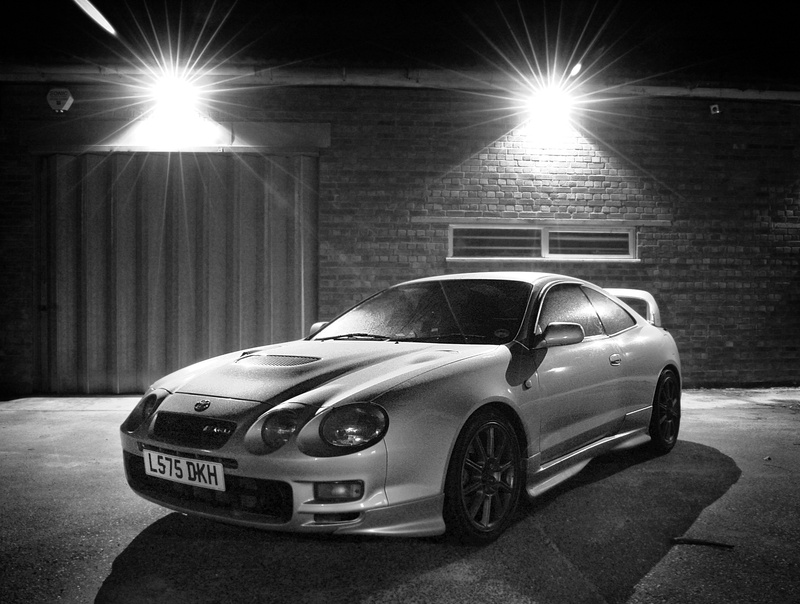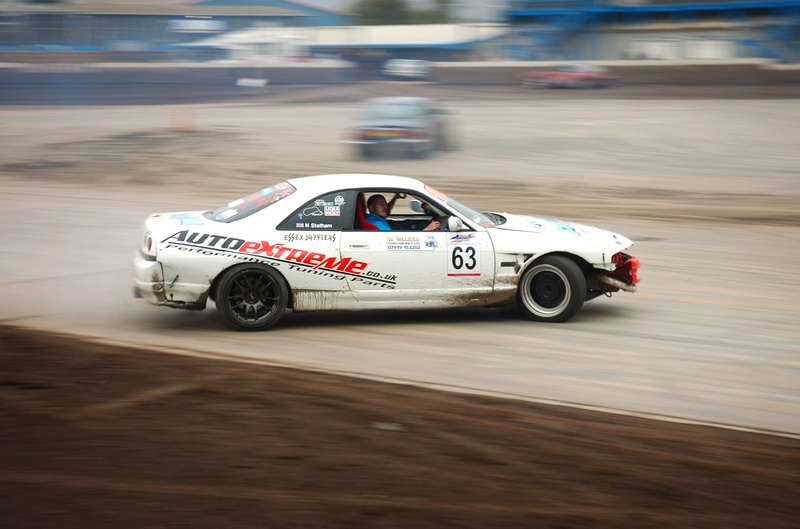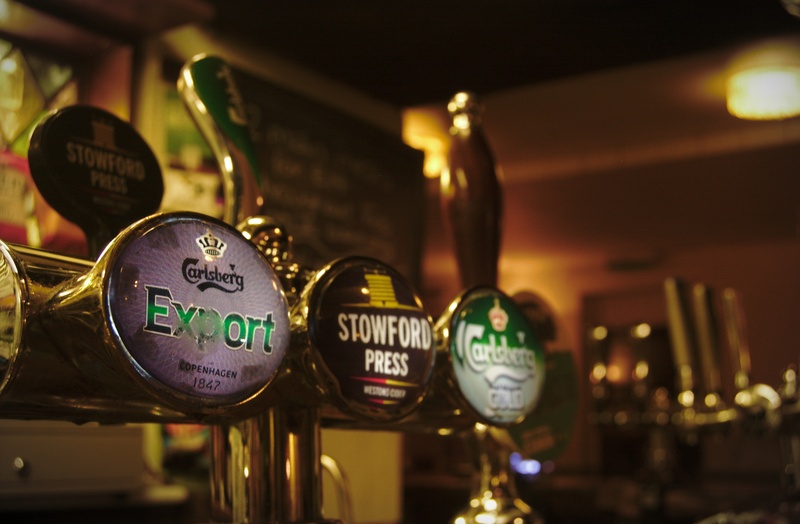
Toyota Celica GT-Four. Nikon D2H, 18-70mm DX, 8 seconds at f/11 and ISO 200.
from Shutter, by Lewis Collard
This article was mostly written some time around 2013 or 2014; I forgot exactly when. It should be read as a time capsule from that era.
A question that comes up from time to time on forums, Flickr and the like is whether it's worth "upgrading" from today's kit Nikon 18-55mm lens to the 18-70mm DX, which is a bigger, heavier lens with a little more reach. Lots of people have opinions on this, and all of them are right. It all depends on what camera you're shooting, what you're shooting with it, and what your priorities are.
I've shot a lot with both of these lots over the last 4 years, and so I'd like to think I have something of value to add here. Even if I don't, that's never stopped me from spouting pointless opinions before, so let's go!!
Both of these lenses are optically great, and you shouldn't worry about any optical deficiencies, let alone differences between lenses, that you may have read about. This is coming from doing actual shooting, with multiple samples. If I tried hard enough, I could set up some test charts and imagine some difference between them that could easily be the fault of sample variation. I don't do that; I like taking photos instead. Don't hesitate to use whatever aperture you need to get the shot you want on either of these lenses, because both are very sharp, even wide-open.
This is one thing I love about Nikon: their kit lenses are often astoundingly good. Of course, both Nikon and Canon's very best f/2.8 telephoto lenses are insanely good, but some of Nikon's cheapest kit lenses are superb, whereas Canon's kit lenses tend to be a little meh. (This is the last you'll hear of Nikon vs Canon on my site, because that stuff is really really boradsdsfgzzzzzzz sorry, my head just hit the keyboard AND ANYWAY)
The 18-55mm focuses about twice as close as the 18-70mm. I'm not an insect photographer or anything, so I've never desired a true macro lens while I had the 18-55mm on my camera.
I seem to find myself worrying a lot more about flare with the 18-70mm, whereas I've never cared about it with the 18-55. I'm not sure there's an actual problem here; it's more likely that I have been shooting in more extreme situations with my 18-70 than my 18-55. Either will be great if you don't push your luck, like trying to shoot into the sun, or straight into very bright points of artificial light outdoors at night. Like this!

Toyota Celica GT-Four.
Nikon D2H,
18-70mm DX, 8 seconds at f/11 and ISO 200.
The 18-70mm weighs about twice as much as the little 18-55mm (or about a hundred grams more than the VR version of the latter). This is great for balancing the weight of pro cameras like the old D2H (or a D200 or D300 with a battery grip), but it feels awkward to me on smaller cameras. It's also significantly larger, which also complements a big camera very well, and feels awkward on a smaller one. It feels too big for the Nikon D70 with which it shipped as a kit lens.
The 18-55 is the reverse complement of the 18-70. It weighs almost nothing and feels great on Nikon's smallest and lightest SLRs. It feels very awkward (and also looks silly) on a professional camera. Nikon doesn't even make a truly professional DX-format camera these days, so if you own a new camera, the 18-55mm will feel perfect on whatever you use.)
I prefer the zoom ring on the 18-55mm. It has a much larger grip (relative to the length of the barrel of the lens), and it has better spacing for my purposes. The 18-70mm seems very bunched up at the wide end and too widely-spaced at the long end. There's a few millimeters between 18 and 24mm and about six feet between 24mm and 70mm.
Manual focus on the 18-70mm is better, because the 18-55mm is pretty terrible. The 18-55mm is like Nikon's very earliest autofocus lenses, in that it has a tiny ring attached to the barrel that holds the front element. Mind the fingers! I almost always use AF when shooting digital, and use a real manual focus lens (or a film camera) if I feel the need for manual focus on still subjects, so this doesn't bother me all that much.
The 18-70mm focuses just about instantly, which is much faster than the 18-55mm. The 18-70mm autofocuses fast enough that it keeps up with the D2Hs running at 8 frames a second shooting drift cars! The 18-55mm is just not fast enough for some of the stuff I shoot (which is more than fast enough for the stills I shoot half of the time, and certainly more than fast enough for all the best photographs I have ever taken).
The 18-70mm is weird at the 70mm end. My 18-70mm sometimes get a bit hung up. If you try and focus it right to its closest focus distance and then lose focus on your subject, it just sits there at 70mm and at the close-focus stop. It's fine if you zoom out just a little and half-press the shutter button again. I thought it was a minor mechanical defect with mine, but nope, I got another 18-70mm with a D200 and it has this problem too. (And on the D200, it sometimes refuses to focus at all at any distance at 70mm!)
Once you get focus, both are as accurate as each other, which is to say, usually perfect with all Nikon cameras.
 Nick Statham, Nikon D2Hs, Nikon 18-70mm DX at 50mm and f/4.8, 1/60 at ISO 200.
Nick Statham, Nikon D2Hs, Nikon 18-70mm DX at 50mm and f/4.8, 1/60 at ISO 200.
Contrary to what would be expected from its greater mass and volume, the 18-70mm is worse in the long term. I've killed three of them. It's a complex and delicate lens! It's easy to break them and they wear them out easily; the big one is zoom rings that get stuck at one end or the other of the zoom range.
You'll be very lucky if you find the 18-70mm new anywhere. This means that you'll probably be buying a used one, which means it'll already have had several years worth of use out of it. You can pick up the 18-55mm new for about the same price as, or cheaper than, you can find the 18-70mm used.
Meanwhile, my little 18-55mm has proven to be remarkably resilient. Even after dropping it with my D2H so hard that it dented the filter ring, half-broke the autofocus mechanism and made the lens useless beyond about 24mm, it still worked well enough that I could shoot it at 18mm well enough to get this:

What actually happened is that I got off a train, mis-stepped, and dropped my camera and lens onto concrete from about four feet. I was returning home from shooting drift racing at the time, and so when I want people to think I lead a much more exciting life than I actually do I can tell them I was shooting drift racing, and I broke my lens. Which is technically entirely true! :D
I'm not sure why the tiny lightweight 18-55mm is more reliable, but I'd guess that it's down to the simpler mechanical design.
While shooting stills, I rarely, if ever, find myself at 70mm on the 18-70mm, and I don't remember a time I wished having an extra 15mm reach on the 18-55mm. The best of my shots are almost all shot at 50mm or less. For me, then, the 18-55mm is just as useful, for things that don't move.
The extra 15mm of the 18-70mm DX is nice (it means I can go out with just the 18-70mm, and no telephoto to tempt me into standing too far away from the action), but with the weird AF problems at the 70mm end, it's only an extra 10mm of dependably useful range.
There was no VR variant of the 18-70mm, whereas most Nikon SLRs sold today ship with the VR variant of the 18-55mm. I owned a couple of the non-VR version 18-55mm lenses, because the non-VR one was cheaper. For most people, VR is a very useful thing to have.
Most people asking this question got an 18-55mm lens in a kit with their camera, which, being free, makes it infinitely better value for money than the 18-70mm. Use it and don't worry about any of this! Nothing is stopping you from taking world-class shots with your kit lens. (This is coming from the guy who owns way in excess of 20 cameras; I never said I wasn't a hypocrite.)
Brand new 18-55mm VR lenses go for about the same as used 18-70mm DX lenses, which is to say, so cheap that what price difference you'll see from time to time isn't a thing over which sleep is worth losing.
Both of these wonderful lenses are about as good as each other, for different purposes. If you are shooting stills and you have either one of these lenses already, don't worry about buying the other. Which is to say: Your 18-55mm kit lens, which you probably already have if you are reading this, will work as well as the 18-70mm and weighs a hell of a lot less. Its zoom ring is also much better at wide angles.
You're welcome!
For shooting anything that moves quickly, you'll really want to get yourself an 18-70mm. "Anything that moves quickly" means motorsports at close range, not your dog; the 18-55mm is fine for that.
After I broke my 18-55mm, the main reasons I got an 18-70mm were 1) because it balances my D2Hs better 2) because it focuses a bit faster. You aren't me, and you aren't anyone else, either; which is to say, you don't necessarily value all the things I do and you may value things I do not.
If you really need the extra 15mm on the long end, then get the 18-70mm, or stand a little closer.
If this doesn't sound like you, stick with the 18-55mm. It's an optically fantastic and very useful lens!
If you get an 18-70mm, be prepared to replace it or have it serviced a few years down the line when it breaks, because it's just not as durable as the silly-looking 18-55mm.